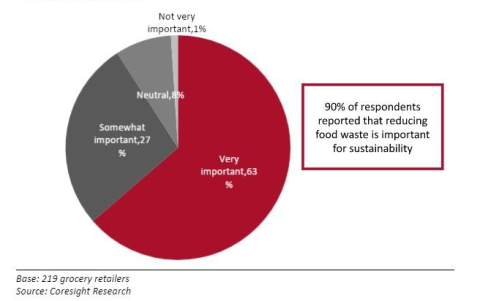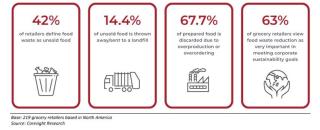How Grocers Are Managing the Large-Scale Problem of Food Waste
MORE Food Waste COVERAGE
Whether it’s packages of sushi tossed at the end of the day in a prepared food department, a produce drawer in a consumer’s home emptied out on garbage night, or crops discarded due to labor shortages, a lot of food is being wasted across the farm-to-table chain.
Just how much? The World Wildlife Federation (WWF) estimates that humans waste about 40% of all food produced on a global scale. That statistic is about the same in the United States, where 108 billion pounds of food is wasted every year, according to Feeding America. Food waste actually takes up most of the space in U.S. landfills, comprising 22% of municipal solid waste.
If food waste is problematic given food insecurities around the world, it’s also affecting the environment. The WWF reports that wasted food represents about 10% of global greenhouse gases and has been a catalyst for the loss of forest, grasslands and other habitats.
In recent years, the issue has come more to the forefront, with agricultural groups, food retailers, consumers and governments expressing interest in curbing food waste in their part of the chain.

As purveyors of food ultimately connecting producers to consumers, grocers play an important role in keeping food waste to a minimum. “Food waste is one of the biggest challenges facing the grocery retail sector, and shoppers are watching,” observes Matt Frost, CEO of United Kingdom-based retail tech company Impulse Logic, whose U.S. office is in San Ramon, Calif. “Food waste puts significant pressure on the bottom line in a rapidly changing and super-competitive marketplace where margins have always been tight.”
Stephen Midgley, VP of marketing for Mississauga, Ontario-based retail tech firm Invafresh, agrees that food waste has moved up the priority list. “We are seeing heightened awareness from consumers, and growing demand for action by grocery retailers,” notes Midgley.
Indeed, food retailers are keenly aware of food waste and its impact on their business as well as on their local communities and the health of the planet. A new survey of North American grocery retailers by New York-based Coresight Research shows that 90% of respondents believe that reducing food waste is important for reaching their sustainability goals, and 72% have set sustainability goals specific to food waste.
Many grocers have already taken action through high-profile programs. Among other initiatives, the Kroger Co.’s “Zero Hunger | Zero Waste” program recently provided $2 million in seed funding to Berkeley, Calif.-based nonprofit ReFED, a group working to reduce food loss and waste. Cincinnati-based Kroger is also going downstream, launching the Food Waste Challenge with the Foundation for Food & Agriculture Research, based in Washington, D.C., to quantitatively measure food waste generated by U.S. households.

Walmart, for its part, is aiming to eliminate food waste by 2025 by increasing the sell-through of its food products through better forecasting and ordering tools. The Bentonville, Ark.-based retailer is taking other steps across its operation, too, like converting food that’s no longer edible to animal feed, compost or energy.
These and other ambitious retailer goals reflect the amount of work to be done in the grocery sector. In its report, Coresight cites research by ReFED showing that about 30% of food in U.S. grocery stores is currently thrown away. Coresight pegs the cost of food waste to the industry at about $16 billion in net income annually.

Breaking it down by industry, Feeding America reports that 43% of food waste in the United States comes from American homes, and 40% stems from grocery stores and foodservice operations. Farms contribute 16%, and manufacturers account for 2%, of food waste.
Within grocery, food waste adds up across many parts of the business. Coresight found that 67.7% of prepared foods are discarded due to overproduction or overordering. A good number — 42% — of retailers define food waste as unsold food.
Turning Sentiment Into Action
While polls of consumers and retailers show consistent support for food waste reduction, the challenges come in how to address it, especially at a time of high inflation and low margins. There are complexities and potential barriers throughout the supply chain, from traditional agricultural practices to grocery staffers who are slow to act to entrenched consumer habits.
Still, many believe that the industry and the marketplace are at a turning point.
“There has long been a gap between interest and action when it comes to food waste,” notes Midgely, “but that gap is starting to narrow as more and more grocery retailers are implementing environmental, social and governance (ESG) factors to measure the ethical and sustainable impact of their operations. In fact, many grocery retailers are now incorporating ESG into their financial reporting and modeling.”

As grocers seek to meet their sustainability objectives that include reducing food waste, they’re taking a range of measures.
Collectively, the industry has come together through the Food Waste Reduction Alliance (FWRA), an initiative of FMI — The Food Industry Association, the Consumer Brands Association and the National Restaurant Association. In 2021, FWRA supported the U.S. government’s goal of halving food waste by 2030.
Grocers can take heed of other government steps to combat food waste. Last year, the Zero Waste Food Act was proposed in the U.S. Congress to, among other things, create a new U.S. Environmental Protection Agency focused on decreasing food waste across the country. In December 2021, the Food Date Labeling Act was introduced to standardize food labeling to include a quality-date indicator and a discard-date indicator.
On an enterprise level, grocers can deploy technologies that are emerging in alignment with the food waste reduction movement. Coresight’s survey of grocers confirms that this is an increasingly popular tactic: 84% of grocers say that they plan to invest in technology over the next two years to manage food waste.
Those technological tools span artificial intelligence (AI), machine learning (ML), blockchain and RFID, among others. Many of the technologies are centered on demand forecasting and inventory management.
“This is where technology plays an important role in addressing these challenges,” says Midgley. “By deploying a fresh intelligent forecasting solution, grocery retailers have greater visibility and control over their operations — whether in-store or commissary — from production planning to recipe management to fresh ordering.” According to Midgley, Invafresh’s Fresh Retail Platform helps eliminate $150 million in food waste annually and helps reduce shrink by 30% across 25,000 stores.

At Impulse Logic, Frost notes that technologies assist grocers in cutting right through to actionable efforts. “Without accurate inventory handling, especially with perishable items, grocers are too often left with items nearing expiration and few options: mark them down for a quick sale and cut into already slim margins, or discard them and add to higher waste,” he explains. “Strides are being made to reduce and divert food surplus waste, but far more must be done. We believe advancements in technology hold the key. AI and ML provide retailers with actionable insights to match supply with demand, improve efficiency, manage markdowns, and reduce overstocking — all needed to reduce waste.”
According to Frost, such technologies can provide a clear picture of inventory and forecasting. “Too many grocers are buried under an avalanche of data they’ve collected that does not lead to solutions,” he notes. “We’ve developed much-needed new machine-learning algorithms that help retailers down to the store level see the true picture of supply and demand and allow for more precise forecasting and stock optimization.”
Even in categories more affected by waste than others, technology can help, Frost adds. “Waste is sometimes inevitable, for perishables especially,” he points out. “ML has the capability to identify the optimal price, helping to protect the product’s margin as it nears its expiry. Instead of simply reducing products by percentage increments, the technology is helping retailers determine the best price based on several key factors and existing retail data points.”
In addition to leveraging technologies like AI and ML, grocers are working to lower food waste in their stores through other actions. Several retailers around the United States have partnered with Toronto-based Flashfood, which offers a program allowing retailers to move items nearing their sell-by date.
Customers can use the Flashfood app to buy these products, which include meat, produce, seafood, deli, dairy and bakery items, at up to a 50% discount and pick them up from a designated area inside their local grocery store. One user, Grand Rapids, Mich.-based Meijer, recently shared that its customers have diverted more than 1 million pounds of potential food waste through the Flashfood program.
Others in the food industry are offering options to consumers seeking to address food waste. Direct-delivery companies Imperfect Foods and Misfit Market, for instance, sell fresh foods and other items that might otherwise go to waste.
Finally, food can be kept out of landfills in a more grass-roots way. In its survey of grocery retailers, Coresight found that 85.6% of unsold food is donated, sold at a discount or to a liquidator, composted, or used to make prepared foods.






